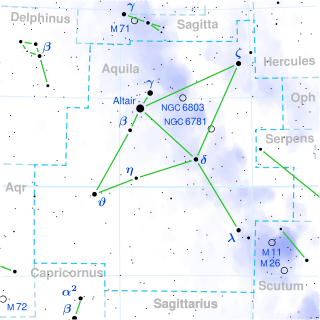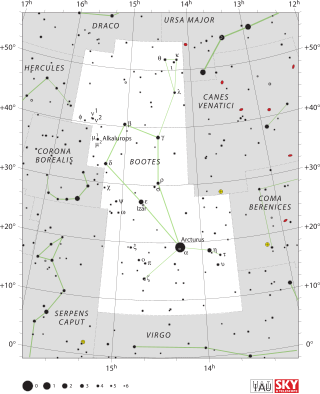
Delta Aquarii, officially named Skat, is the third-brightest star in the constellation of Aquarius. The apparent visual magnitude is 3.3, which can be seen with the naked eye. The distance to this star is about 113 light-years based upon parallax measurements, and it has a close companion.

98 Aquarii is a star in the equatorial constellation of Aquarius. 98 Aquarii is the Flamsteed designation, although it also bears the Bayer designation b1 Aquarii. It is visible to the naked eye with an apparent visual magnitude of +3.97. The distance to this star, 163 light-years, is known from parallax measurements made with the Hipparcos spacecraft.

91 Aquarii is the Flamsteed designation for a triple star system in the equatorial constellation of Aquarius. It also bears the Bayer designation Psi1 Aquarii. It is visible to the naked eye with an apparent visual magnitude of +4.248. Parallax measurements yield an estimated distance of around 150 light-years from Earth. An extrasolar planet is known to orbit the main star.

99 Aquarii is a star in the equatorial constellation of Aquarius. 99 Aquarii is the Flamsteed designation, although it also bears the Bayer designation b2 Aquarii. It is visible to the naked eye with an apparent visual magnitude of 4.38; according to the Bortle Dark-Sky Scale this is bright enough to be seen even from city skies under ideal viewing conditions. Based upon parallax measurements, the distance to this star is around 283 light-years.
104 Aquarii (abbreviated 104 Aqr) is a star in the equatorial constellation of Aquarius. 104 Aquarii is the Flamsteed designation, although it also bears the Bayer designation A2 Aquarii. Based on an annual parallax shift of only 3.89 ± 0.25 milliarcseconds, the distance to this star is about 840 light-years (260 parsecs). At that range, the brightness of the star in the V-band is reduced by 0.10 magnitudes as a result of extinction caused by intervening gas and dust.

25 Aquarii is a single star in the equatorial constellation of Aquarius. 25 Aquarii is the modern Flamsteed designation; in the past it held the designation 6 Pegasi. It also bears the Bayer designation of d Aquarii. It is located near the border with the modern Pegasus constellation. Although faint at an apparent visual magnitude of +5.09, it is bright enough to be viewed from suburban skies. Based upon an annual parallax shift of 0.01440 arcseconds, it is located at a distance of around 226 light-years from Earth. The visual magnitude of the star is diminished by 0.09 from extinction caused by intervening gas and dust.
68 Aquarii is a single star located 270 light years away from the Sun in the zodiac constellation of Aquarius. 68 Aquarii is its Flamsteed designation, though it also bears the Bayer designation of g2 Aquarii. It is visible to the naked eye as a dim, yellow-hued star with an apparent visual magnitude of 5.24. The object is moving further from the Earth with a heliocentric radial velocity of +24.5 km/s.
42 Aquarii is a single star located 447 light years away from the Sun in the zodiac constellation of Aquarius. 42 Aquarii is its Flamsteed designation. It is visible to the naked eye as a faint, orange-hued star with an apparent visual magnitude of 5.34. This object is moving further from the Sun with a heliocentric radial velocity of around +13 km/s.
18 Aquarii is a single, yellow-white hued star in the equatorial constellation of Aquarius. The designation is from the catalogue of English astronomer John Flamsteed, first published in 1712. The star is faintly visible to the naked eye with an apparent visual magnitude of 5.49 and is located about 154 light-years from Earth.
77 Aquarii is a single star located 135 light years away from the Sun in the equatorial constellation of Aquarius. 77 Aquarii is its Flamsteed designation. It is visible to the naked eye as a dim star with a baseline apparent visual magnitude of 5.55. The star is moving closer to the Earth with a heliocentric radial velocity of −35 km/s.
5 Aquarii is a single star in the zodiac constellation of Aquarius, located about 830 light years away from the Sun, based on parallax. 5 Aquarii is the Flamsteed designation. It is visible to the naked eye as a faint, blue-white hued star with an apparent visual magnitude of 5.55. This object is moving closer to the Earth with a heliocentric radial velocity of −3 km/s.
44 Aquarii is a single star located 336 light years away from the Sun in the equatorial constellation of Aquarius. 44 Aquarii is its Flamsteed designation. It is visible to the naked eye as a dim, yellow-hued star with an apparent visual magnitude of 5.75. This body is moving away from the Earth with a heliocentric radial velocity of +7.4 km/s.
16 Aquarii, abbreviated 16 Aqr, is a star in the constellation of Aquarius. 16 Aquarii is the Flamsteed designation. It is a faint star, just visible to the naked eye, with an apparent visual magnitude of 5.869. Based upon an annual parallax shift of 9.5 mas, it is located about 342 light years away. It is moving closer to the Earth with a heliocentric radial velocity of −6 km/s, and is predicted to come within 220 light-years in 6.8 million years.
60 Aquarii is a star located 375 light years away from the Sun in the equatorial constellation of Aquarius. 60 Aquarii is its Flamsteed designation. It is visible to the naked eye as a dim, yellow-hued star with an apparent visual magnitude of 5.89. The star is moving closer to the Earth with a heliocentric radial velocity of –8 km/s.
17 Aquarii, abbreviated 17 Aqr, is a spectroscopic binary star system in the constellation of Aquarius. 17 Aquarii is the Flamsteed designation. It appears to the naked eye as a faint sixth magnitude star, having a combined apparent visual magnitude of 5.99. The distance to 17 Aqr can be estimated from its annual parallax shift of 4.9 mas, which yields a separation of around 660 light years. It is moving further away with a heliocentric radial velocity of 18 km/s.

27 Aquilae is a star in the equatorial constellation of Aquila. 27 Aquilae is its Flamsteed designation though it also bears the Bayer designation d Aquilae. It has an apparent visual magnitude of 5.49, which is faintly visible to the naked eye. Based upon parallax measurements made during the Hipparcos mission, this star is at a distance of 440 light-years from Earth, give or take a 20 light-year margin of error. At this distance, the brightness of the star is diminished from extinction caused by interstellar gas and dust.

Rho Boötis, Latinised from ρ Boötis, is a single, orange-hued star in the northern constellation of Boötes. It is visible to the naked eye with an apparent visual magnitude of 3.59. Based upon parallax measurements, it is located at a distance of approximately 160 light-years from Earth. It is moving toward the Sun with a radial velocity of −13.6 km/s. There is an optical companion, a magnitude 11.5 star, located 34.7 arcseconds away along a position angle of 345°.
28 Aquarii is a single star located about 560 light years away from the Sun in the zodiac constellation of Aquarius. 28 Aquarii is the Flamsteed designation. It is visible to the naked eye as a dim, orange-hued star with an apparent visual magnitude of 5.6. This object is moving further from the Earth with a heliocentric radial velocity of +8.1 km/s.
40 Aquarii is a star in the equatorial constellation of Aquarius. 40 Aquarii is its Flamsteed designation; it was too faint to be included in the Bright Star Catalogue. The brightness of this star is below the normal limit for visibility with the naked eye, having an apparent visual magnitude of 6.93. Based upon parallax measurements, it is located about 726 light-years away from the Sun. It is moving closer to the Earth with a heliocentric radial velocity of -3 km/s. 40 Aquarii is positioned near the ecliptic and thus is subject to lunar occultations.

47 Capricorni is a variable star located around 1,170 light years from the Sun in the southern constellation Capricornus, near the northern border with Aquarius. It has the variable star designation of AG Capricorni and a Bayer designation of c2 Capricorni; 47 Capricorni is the Flamsteed designation. This object is visible to the naked eye as a dim, red-hued point of light with an apparent visual magnitude that varies between 5.90 and 6.14. The star is receding from the Earth with a heliocentric radial velocity of +20 km/s.





